The 10 Best Low-Protein Dog Foods in 2025

High-protein diets for dogs may get all the attention, but for some dogs, cutting down on protein is better for their health. The bad news is these foods are notoriously hard to find, and there’s really no one number to read to know if a dog food is low in protein.
We’ve scoured through the options to help pet owners decide which low-protein dog food is right for their pup.
- Most Important Factors in Choosing a Low-Protein Dog Food
- Top 10 Best Low-Protein Dog Foods 2025
- 1. Best Overall Food: Blue Buffalo Life Protection Healthy Weight
- 2. Best Premium Food: Dr. Harvey’s Canine Health Miracle Dog Food
- 3. Best Budget Food: Diamond Naturals Adult Lamb & Rice
- 4. Best Vet-Prescribed Food: Hill’s Prescription Diet k/d
- 5. Best for Small Breeds: Hill’s Science Diet Small Bites
- 6. Best for Seniors: Nutro Ultra Senior
- 7. Best Grain-Free Food: Blue Buffalo Basics Limited Ingredient Diet
- 8. Best for Sensitive Stomachs: Natural Balance L.I.D.
- 9. Best for Picky Eaters: Canidae Grain-Free Pure Petite
- 10. Best Canned Food: Hill’s Science Diet Weight Management
- Complete Guide to Low-Protein Dog Food
- Low-Protein Dog Food FAQs
- Final Thoughts
Most Important Factors in Choosing a Low-Protein Dog Food
All choices pet owners make regarding what to feed their dogs are difficult and involves any number of considerations. Fortunately, when picking a low-protein dog food, there are only a few reasons why — and those reasons will drive the other decisions.
Reasons for Low-Protein Diet
Most dogs won’t benefit from a low-protein diet, but vets often recommend them for dogs that have kidney or liver disease or suffer from another condition that makes it tough for their bodies to process protein. For these dogs, a dietary change can help support other medical recommendations by removing some of the workload of these organs. (You can learn more here about the specific conditions in question and their symptoms.)
Protein Content
Though there is some standardization in dog food labeling, there’s no set metric that determines a low-protein food, but it’s safe to say that the closer to or below you get to 20% protein, the nearer you are to true low-protein food. This rules out most dog food, so scope expansion is necessary. Plus, a diet that’s low-ish in protein may be beneficial, so we’ve considered dog foods with no more than 28% protein.
Other Nutrition
Your dog will ideally get all the nutrients they need from their dog food, so it’s important to have balance, and there are some ingredients that many pet owners consider a bonus. This includes things like glucosamine and chondroitin. Also, for overall health reasons, it’s important to limit the phosphorous content in a low-protein dog food.
Flavor
One unfortunate aspect of low-protein dog foods is they tend to taste bad, even from the perspective of a dog. Some dogs don’t care and will eat whatever you put in front of them, but if you’ve got a picky eater on your hands, the flavor may be particularly important to you.
Food Type
All but one of the foods on our list is dry, and the canned food that made the cut also has the highest protein content. Dogs that need a diet low in protein will most likely need to eat dry food, as that’s the majority of what’s available.
Price
The good news is low-protein foods aren’t really any more expensive than high-protein foods, and most of the foods that made our list are widely available and affordable.
Now that you have an idea of what qualities to consider, let’s dive into our top choices for dogs who require low-protein diets.
Top 10 Best Low-Protein Dog Foods 2025
1. Best Overall Food: Blue Buffalo Life Protection Healthy Weight
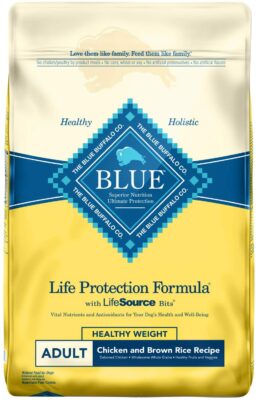
Editor’s Rating:
Why we like it: Blue Buffalo’s Life Protection Healthy Weight version provides the ideal balance of relatively low protein content as well as a low price, and it does this all without stripping away important nutrients that all dogs need.
At a Glance
- Protein content: 20%
- Fat content: 9%
- Major ingredients: Chicken, brown rice, peas, oatmeal
- Price: $
Nutrition
It’s not grain-free, but Blue Buffalo’s Life Protection Healthy Weight formulation strips out some protein without losing important nutritional benefits. It’s got a good balance of calcium and phosphorous, which is crucial for dogs with the kinds of health issues that benefit most from low-protein diets. Plus, it includes omega fatty acids as well as glucosamine and chondroitin, which can help dogs stave off joint health issues later in life.
Unlike most others on the list, this food also doesn’t exchange fat for protein, so this food is quite low in fat, though that may make it less palatable for picky pups.
Value
This is the second-cheapest food to make our list, and while it doesn’t have the lowest protein content of all the options here, it perhaps does the best job of lowering protein content without increasing price.
Good to Know
Other formulations are available in the Life Protection line from Blue Buffalo, but none offer the healthy weight label, though that may not be an issue for dogs that have kidney or liver problems that respond to a low-protein diet. For dogs that aren’t prone to carrying extra weight, other flavor options may be more appealing, including a version with fish and another with lamb. The healthy weight version offers chicken as its main protein, and the mixture of ingredients can produce — well, there’s no good way to say this — terribly smelly dog farts.
Pros
- Protein content below average (20%)
- Low-fat content
- Good mix of nutrients
- Low price
Cons
- Bland flavor
- Can cause gas
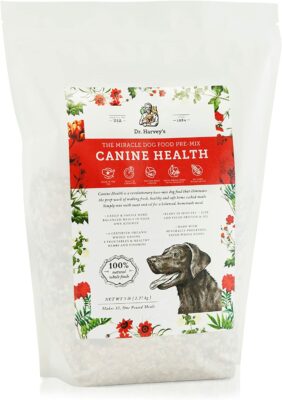
Editor’s Rating:
Why we like it: We’re not sure it qualifies as a miracle, but Dr. Harvey’s gives pet owners the chance to easily make their own dog food by giving them a base mix they rehydrate by adding hot water and then tossing in the protein of their choice.
At a Glance
- Protein content: NA
- Fat content: NA
- Major ingredients: Oats, barley, rice, sweet potatoes, carrots, peas
- Price: $$$
Nutrition
The precise mix of nutrients in this food will vary from preparation to preparation, so amounts of protein, fat, and oil aren’t listed. But the ingredients that are included, from sweet potatoes and carrots to alfalfa and kelp, add important nutrients for overall well-being, including vitamin E and folic acid. The mix of calcium to phosphorous is excellent for kidney health.
Value
Dr. Harvey’s is by far the most expensive low-protein dog food on our list, and many folks would probably argue that it’s more groceries than food. While the food is expensive to purchase month after month, it will probably go farther than it seems because it’s dehydrated, and you’ll add whatever proteins and oils (be sure to follow the instructions) your dog likes or needs.
Good to Know
Some dogs with sensitivity to large numbers of ingredients, as this food has, may have problems with their digestive system adjusting to the new food once you make the switch, and it’s a fairly bland mix, though as the one who actually controls what goes into the bowl, you have a lot of say with that.
Pros
- Customizable
- Nutrient-dense
- Wholesome ingredients
- Good calcium-phosphorous balance
Cons
- Expensive
- Bland flavor
3. Best Budget Food: Diamond Naturals Adult Lamb & Rice
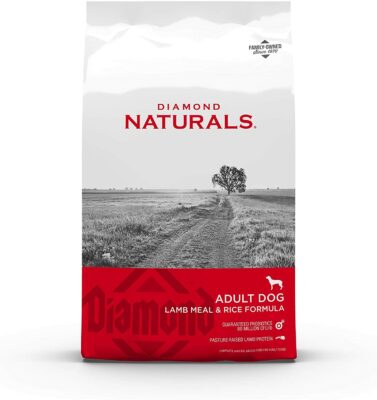
Editor’s Rating:
Why we like it: It’s the cheapest food on this list, and while it’s also one of the most flavorless, the nutritional content is solid, which makes Diamond Naturals’ adult lamb and rice formulation an excellent option for budget-conscious pet owners.
At a Glance
- Protein content: 23%
- Fat content: 14%
- Major ingredients: Lamb, rice, barley, egg
- Price: $
Nutrition
Diamond Naturals’ adult formula with lamb and rice sits smack in the middle of the pack when it comes to protein content, and it has a slightly above-average fat content. But with a good balance of calcium to phosphorous, as well as omega fatty acids and taurine, which can help boost heart health, the nutritional content is quite high.
Value
When you look at the price — this is by far the lowest-priced dog food on this list, by about half — the nutritional content looks even better. Yes, some foods are lower in protein and potentially richer in nutrients, but none offer solid nutrition at this low a price.
Good to Know
Even for a low-protein food, the flavor of Diamond Naturals’ adult lamb and rice version is, well, almost non-existent despite the food having a higher-than-average amount of fat. Many pet owners feeding their canine companions a low-protein diet find it necessary to add a bit of water to the food or consider a low-protein topper.
Pros
- Inexpensive
- Solid nutritional content
- Good calcium-phosphorous balance
- Taurine
Cons
- Higher than average fat content
- Very bland flavor
4. Best Vet-Prescribed Food: Hill’s Prescription Diet k/d
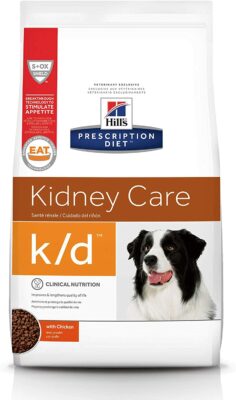
Editor’s Rating:
Why we like it: Though you’ll need a doctor’s note to get it (importantly, even if you order online), Hill’s Prescription k/d formula is the only food on the list that actually can be considered low-protein in a medical sense, and it was crafted especially for dogs with kidney disease.
At a Glance
- Protein content: 15%
- Fat content: 22.5.%
- Major ingredients: Rice, pork fat, egg
- Price: $$
Nutrition
As we mentioned, Hill’s Prescription k/d food is the only one on the list that contains what is considered, at least according to dog food labels, to be low protein. With just 15% protein content, this food was designed to help dogs dealing with chronic kidney disease, which is one of the biggest reasons why vets recommend a low-protein diet for dogs. While it’s high in fat, it’s very low in phosphorous, which should help dogs whose kidneys and livers struggle to keep up with their important tasks.
Value
It’s not reasonable to describe this food as cheap, but if your beloved dog has chronic health problems that keep her from being able to process protein in her food, is there too high a price? Also, it’s not the most expensive food on the list, so the return on investment is potentially quite high.
Good to Know
Many pet owners purchase this food from their veterinarian directly, but it’s also possible to purchase it online. However, you will have to provide details about your pet and veterinarian, and the seller will need to verify that your dog has been prescribed this food. Sensitive pups may find the high-fat content too rich for their tummies at first, but the added fat may make it more palatable for finicky eaters.
Pros
- Lowest protein content
- Lowest phosphorous content
- Strong flavor
- Formulated for chronic kidney disease
Cons
- Requires prescription
- High fat
5. Best for Small Breeds: Hill’s Science Diet Small Bites
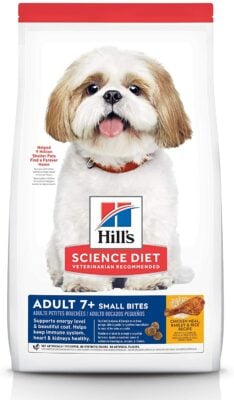
Editor’s Rating:
Why we like it: With kibble designed for petite mouths, Hill’s Science Diet Small Bites is ideal for small breed dogs who need a food that can help address both kidney or liver issues and help head off heart problems thanks to the inclusion of carnitine along with the reduction in protein.
At a Glance
- Protein content: 18.7%
- Fat content: 13.7%
- Major ingredients: Chicken meal, barley, rice
- Price: $$
Nutrition
Hill’s Science Diet Small Bites has one of the lowest percentages of protein among the food on this list, though the ingredient set is dominated by grains like barley, rice, wheat, and corn. That means pet owners hoping to feed grain-free will need to look elsewhere, though grain-free and low-protein is a tricky needle to thread. Otherwise, the nutritional content is excellent, and the formulation includes many added benefits for small dogs, such as omega fatty acids, glucosamine, and carnitine, which is helpful in managing heart disease to which small breeds are prone. This food is also quite low in phosphorous compared to calcium.
Value
Other foods on the list offer better bang for the buck, though no others have been designed with small breeds in mind, so when you consider the nutritional benefits and things like small kibble that’s easy for little mouths, the mid-range price is fair.
Good to Know
The fat content in Hill’s small breed food is on the high side compared with other food on this list, but the boosted fat content doesn’t help make it more enticing, and picky eaters will likely need some enticement to eat all their food.
Pros
- Among lowest in protein
- Good calcium-phosphorous balance
- Carnitine
- Glucosamine
Cons
- High in fat
- Grains dominate ingredient list
6. Best for Seniors: Nutro Ultra Senior
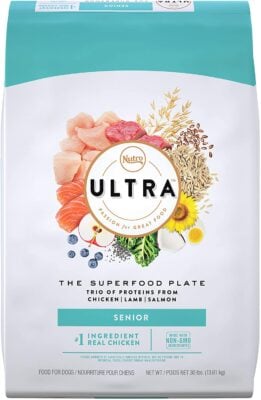
Editor’s Rating:
Why we like it: Nutro Ultra’s senior blend provides a nutrient punch thanks to the inclusion of trendy superfoods, and while the protein content is one of the highest, it’s also well below average when it comes to price.
At a Glance
- Protein content: 26%
- Fat content: 11%
- Major ingredients: Chicken, rice, lamb meal, salmon meal
- Price: $
Nutrition
Nutro Ultra’s senior formulation has one of the highest ratios of protein on our list, but it also is relatively low in fat compared to others. With meat ingredients like chicken, lamb, and salmon, the included protein comes largely from lean sources, which helps keep the fat content low. In addition, the blend offers joint support via chondroitin and fatty acids, which can help keep older dogs happy and healthy.
Value
Other foods have much more dramatically reduced their protein content, which probably makes them better options for dogs who have a pressing medical reason to cut protein as low as possible, but most of those foods are also considerably more expensive. So, for owners of senior dogs who may not yet have an urgent medical need to reduce protein, Nutro Ultra’s senior blend may be ideal, as it does cut some protein while still including benefits for older dogs.
Good to Know
Like many of the best senior dog foods, Nutro Ultra’s senior blend is packed with so-called superfoods like kale, blueberries, chia seeds, and spinach, which help to add antioxidant properties. These ingredients also may help encourage your dog to try this food, as the flavor is stronger than most other foods on this list. Also, the ratio of calcium to phosphorous is close to even, which could be a challenge for dogs with weak kidneys or livers.
Pros
- Inexpensive
- Chondroitin
- Omega fatty acids
- Strong flavor
Cons
- Among highest protein content
- Poor calcium-to-phosphorous balance
7. Best Grain-Free Food: Blue Buffalo Basics Limited Ingredient Diet
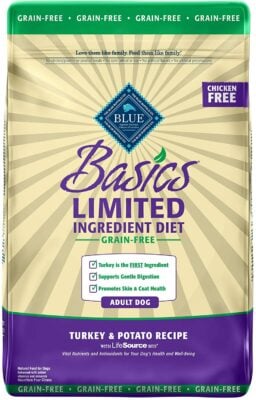
Editor’s Rating:
Why we like it: A low-protein diet for dogs often means one that’s high in grains, but as Blue Buffalo Basics LID food shows, that doesn’t always have to be the case. Among the few grain-free foods on this list, this one has both the highest protein content and lowest price.
At a Glance
- Protein content: 20%
- Fat content: 12%
- Major ingredients: Turkey, potatoes, pea protein, fish oil
- Price: $
Nutrition
Though it’s a limited-ingredient formulation, Blue Buffalo Basics LID food is grain-free and has one of the lowest ratios of protein among the foods on our list. While the calcium-to-phosphorous ratio is within a good range, it’s not among the standouts, so for dogs who have difficulty processing phosphorous, other foods may be better. Other nutritional benefits include omega fatty acids, glucosamine, and chondroitin.
Value
This is the least expensive grain-free food to make our list, so for pet owners who want to feed their dogs a low-protein diet that’s also grain-free, this is the most affordable option without a doubt.
Good to Know
Blue Buffalo Basic’s LID formulation is one of the few on this list to have an ingredient set that’s not led by chicken, as the main protein source is turkey. That doesn’t mean the flavor is all that strong, but for dogs who turn their noses up at chicken, turkey could be a welcome substitute.
Pros
- Grain-free
- Among lowest protein content
- Inexpensive
- Glucosamine and chondroitin
Cons
- Poor calcium-to-phosphorous ratio
- Bland flavor
8. Best for Sensitive Stomachs: Natural Balance L.I.D.
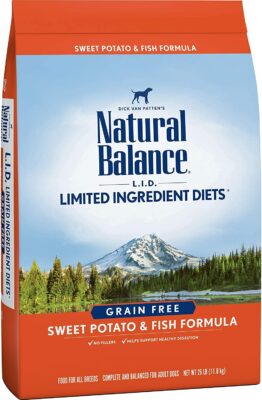
Editor’s Rating:
Why we like it: This dog food is grain-free and relatively low in protein, making it an excellent option for dogs who have sensitive stomachs but also need to cut out some protein.
At a Glance
- Protein content: 24%
- Fat content: 10%
- Major ingredients: Sweet potatoes, salmon, fish meal
- Price: $$
Nutrition
This grain-free food has a ratio of protein that’s higher than the average of all foods on this list, but the limited ingredient set was designed for dogs who have sensitive systems, making this food quite helpful for dogs with kidney or liver disease whose systems have difficulty processing a variety of ingredients.
That said, the calcium-to-phosphorous ratio is a bit high, which could spell trouble for dogs whose kidney or liver problems are moderate to severe, and there are other foods that offer additional nutritional bonuses like glucosamine or chondroitin.
Value
Natural Balance’s LID formulation is in the middle of the range among the three grain-free foods on our list, and its low-fat content makes it the most ideal of the three when it comes to avoiding ingredients that will trigger digestive upset in dogs.
Good to Know
Other LID versions from Natural Balance include exotic proteins like bison, duck, and venison, as well as a chicken version nearly identical to this one, which offers sweet potato and fish. That means owners of sensitive stomach dogs who also happen to be picky eaters could opt for a different flavor that might be more interesting, though as with most low-protein foods, no version is especially delicious.
Pros
- Grain-free
- Good value
- Limited-ingredient list
- Multiple flavor options
Cons
- Poor calcium-to-phosphorous ratio
- Bland flavor
9. Best for Picky Eaters: Canidae Grain-Free Pure Petite
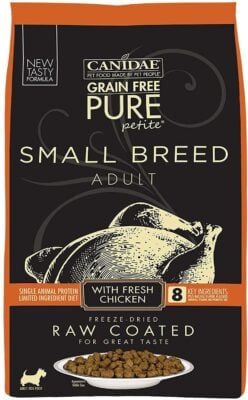
Editor’s Rating:
Why we like it: A low-protein food is only effective if your dog will actually eat it, and this Canidae grain-free version gives dogs an extra treat thanks to a freeze-dried meat coating on each bit of small-sized kibble.
At a Glance
- Protein content: 24%
- Fat content: 12%
- Major ingredients: Chicken, peas, lentils, tapioca
- Price: $$
Nutrition
As another limited-ingredient diet food, Canidae’s Grain-Free Pure Petite is a good option for dogs who are sensitive to other foods, but this one has a special bonus. In addition to the LID diet, the kibble in this food has a freeze-dried meat coating applied to help entice dogs who normally turn their noses up at other foods.
This does make it slightly above average in protein content, though it’s not particularly high in fat. However, it does include important nutrients like taurine, which is ideal for dogs who are prone to heart problems, as well as antioxidants and probiotics.
Value
This food is the most expensive of the grain-free options on this list, though to be fair, there are very few of those, and it’s far from the most expensive food on the list.
Good to Know
Two other flavor options are available with the same nutritional content — salmon or lamb, so pet owners can help placate their dogs’ demanding diets. The kibble is sized for small dogs, so owners of larger dogs may want to consider the alternatives.
Pros
- Grain-free
- Multiple flavor options
- Limited-ingredient diet
- Strong flavor
Cons
- Relatively high protein content
- Most expensive grain-free option
10. Best Canned Food: Hill’s Science Diet Weight Management
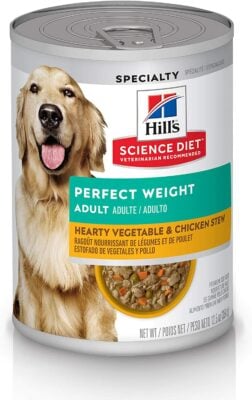
Editor’s Rating:
Why we like it: While it barely makes the cut as a low-protein food, Hill’s Science Diet weight management canned version doesn’t ramp up the fat content to make up for losing protein, and it can help picky pups clean their plates.
At a Glance
- Protein content: 27.9%
- Fat content: 12.4%
- Major ingredients: Chicken broth, pork liver, carrots, green peas
- Price: $$$
Nutrition
Hill’s Science Diet canned weight-management food has the highest protein content of the foods on this list, though it’s the only canned food with protein content low enough to be considered for inclusion with just under 28% protein. However, it’s not the highest in fat, which is due to being a weight-management formula, and it includes added nutrients like taurine and carnitine, which are both helpful for managing heart problems in dogs. The calcium-to-phosphorous ratio is acceptable, though not ideal for dogs who have moderate to severe kidney or liver disease.
Value
This is the second most expensive food on the list, which is common with canned food, though many pet owners may add this to their dog’s dry food as a low-protein flavor enhancer, which will help it go further.
Good to Know
Hill’s Science Diet weight maintenance formula comes in two versions — a stew, which looks, well, like stew, and a loaf version that’s a bit more ground up. However, both have chicken as their chief flavor.
Pros
- Low fat
- Taurine
- Carnitine
- Strong flavor
Cons
- Expensive
- Highest protein content
Complete Guide to Low-Protein Dog Food

Because most dog foods celebrate their high protein content, it can be especially difficult to understand exactly what makes for a good low-protein option. So, let’s attempt to demystify the reasons behind choosing a low-protein diet for your dog and some specific markers of quality in these foods.
Reasons for Choosing a Low-Protein Diet
All living organisms require protein to function, as it’s a crucial biological building block for almost every process in the body. But some dogs may benefit from a low-protein diet, mostly because they are dealing with some type of major illness.
Liver Disease
In dogs, as in humans, the liver is a large organ that serves several major functions, including aiding in digestion, detoxifying a dog’s entire system, and metabolizing proteins. Age-related liver dysfunction can affect the liver’s ability to efficiently perform its biological functions, and in dogs with chronic or age-related liver disease, a veterinarian may recommend a low-protein diet to help take some of the strain off the liver. Signs of liver disease in a dog include weight loss, vomiting, diarrhea, increased thirst, confusion, and jaundice, and it’s typically diagnosed through blood tests or diagnostic imaging, such as an X-ray or ultrasound.
Kidney Disease
A dog’s kidneys just like in a person filter and balance various substances within the bloodstream, and they’re responsible for helping regulate important processes like blood pressure. Through aging or via conditions like diabetes, a dog’s kidneys can lose their ability to perform their processing function, and in some cases, it may be helpful to switch to a low-protein diet so that the body has less protein it needs to process. Symptoms of kidney disease or kidney failure in dogs include lethargy, weight loss, decrease in appetite, and changes in urine volume or water intake. Kidney problems are typically diagnosed in dogs using a urine test, but bloodwork may also be involved.
Bladder Stones
Dogs that are prone to a particular type of bladder stone, a urate stone, may benefit from a low-protein diet because the substances that create these stones are found in high concentrations food-based protein sources. Urate bladder stones are relatively rare (only about 5% of all bladder stones in dogs), but some breeds are much more prone to them, including Dalmatians and bulldogs.
Introducing New Food
Even if a major health concern is leading you to make the switch to a low-protein diet for your dog, this change should be made gradually rather than all at once. Dogs who are subjected to sudden, dramatic changes in their food can have digestive problems that can cause dehydration, which can be dangerous for dogs with kidney or liver disease.
Following a schedule can help you safely make the switch without upsetting your dog’s system.
Day 1-2
Feed your dog the same number of calories as before but make the ratio 75% old food and 25% new food. If you see signs of digestive upset, dehydration, or other problems, pause the switch and consult with your vet.
Day 3-4
Give your dog a 50/50 mix of old food and new food, and if they tolerate it well, proceed to the next step on the schedule. If at any point, your dog refuses to eat the new food, consider adding a bit of water to it, or try a flavor enhancer like a topper or pieces of a low-protein treat.
Day 5-6
By the fifth day, your dog should get a ratio of 25% old food and 75% new food.
Day 7
On the seventh day, if all has gone well, your dog should be fully switched over to the new food.
How Low Should You Go?
A low-protein diet doesn’t mean a total absense protein, and there isn’t one single number that indicates when a food is low in protein. For the purposes of this ranking, we found it helpful to consider two big points:
- The Association of American Feed Control Officials (AAFCO), an industry group that establishes pet food labeling standards, considers 18% to be the minimum recommended protein content for dogs. Only one of the foods on our list has protein content lower than that — Hill’s Prescription k/d, and you can only get it through a veterinarian’s prescription.
- Dog food advertising tends to take a “the more the merrier” approach to discussing protein content in food. Our analysis found that among popular foods that claim to be high protein, they range from about 30% to 40% protein content. For the purposes of this analysis, we limited our reviews to foods with no more than 28% protein content.
Phosphorous
In addition to lowering protein to help maintain good health in dogs with chronic or acute problems, it’s also important to restrict the amount of phosphorous in a dog’s diet. Evidence suggests that reducing phosphorous in the diet of a dog with kidney disease can delay the progression of the condition.
The best way for pet owners to do this is to check the balance of calcium and phosphorous in a food and ensure it has more calcium as a percentage of all content than phosphorous. There isn’t one ratio that’s considered good, but generally, it’s better to have more calcium in dog food than phosphorous. Essentially, the further you get from a 1:1 ratio, the more medically appropriate the food likely will be for a dog who has moderate to severe health problems that necessitate a low-protein diet.
Other Ingredients
A low-protein diet shouldn’t force you to abandon all other nutrients that your dog needs. For example, if your dog has already had or is a breed prone to joint health, you may want to consider a food with glucosamine and/or chondroitin. If your dog’s breed is one that’s predisposed to heart trouble, foods that have ingredients like taurine and carnitine may help prevent or delay onset of cardiac problems.
Also, dog food that’s low in protein tends to be higher in fat, so if your dog is especially inactive, you will need to closely monitor their weight to ensure they don’t gain an unhealthy amount of weight on their new food.
Regular Monitoring
Pet owners should never move their dog to a low-protein diet without consulting their veterinarian. In fact, low-protein diets may be one of many modifications your vet suggests for a dog with the health issues that would benefit from such a diet.
In addition to dietary modifications in consultation with your vet, it’s also important that your dog undergoes regular monitoring, which could include urinary and blood tests. This should generally be done more frequently than your dog’s once-a-year exams, and your vet will guide you in this area.
But as the person who sees your dog every day, it’s also important to monitor her for weight gain or weight loss or any other sudden changes once you make the switch to a low-protein diet. In some cases, these may be temporary, but be sure to communicate any changes with your vet so you can avoid major health complications.
Your Dog’s Size, Age & Stage of Life
Older dogs are more prone to the conditions for which low-protein diets are recommended, but canine kidney disease can happen at any stage of life. All the foods on this list are meant for adults or senior dogs, and a low-protein diet is not recommended for puppies. If your puppy has chronic kidney or liver disease, your vet will make a dietary recommendation that will ensure your pup receives the nutrients he needs to ensure good brain development.
Flavor
Unfortunately, the loss of protein often means that these foods won’t be winning any gustatory awards from your dog — in other words, they’ll probably taste terrible, worse than typical dog food.
It’s still important for your dog to eat all of his food to maintain proper nutrition, so many pet owners will enhance the flavor of low-protein dog food by adding a bit of water to kibble, while others turn to treats or dog food toppers, like these soft (and cute) treats. If you do add anything to your dog’s food, be sure to appropriately balance his total calorie intake. Or consider adding a low-protein canned food as an enhancer.
Low-Protein Dog Food FAQs
Is a Low-Protein Diet Safe for Dogs?
Most dogs should not be on a low-protein diet but reducing protein in your dog’s diet can be among the recommendations a veterinarian makes for dogs that have been diagnosed with kidney or liver disease. For these dogs, high-protein diets can impact their health and even shorten their lives, so low-protein foods are safer for dogs who have these medical issues.
Can You Feed a Puppy a Low-Protein Diet?
Typically, low-protein food should not be given to a puppy. Protein is critical for the function of all living organisms, and it’s usually recommended that puppies consume more protein than adult dogs to help stimulate growth and brain development. If your puppy shows symptoms of kidney or liver problems, your vet will help you figure out the best diet to balance all her unique health needs.
What Is Considered Low Protein?
There isn’t a single legal or regulatory protein level that’s considered low. However, a dog food labeling organization has established a minimum acceptable protein content in dog food of 18%, and our analysis found it was safe to consider anything between 15% and 28% protein to be a low-protein dog food.
What Low-Protein Meats Can I Give My Dog?
Whether they’re considering what food to give their dog or just looking for a dog treat that’s low in protein, some meats are much lower in protein than others. White fish, also known as crab sticks or imitation crab, is one of the lowest-protein meats, and eggs also are low in protein compared to other meats. Chicken, beef, and pork are the major types of meat highest in protein.
Final Thoughts
It’s fair to say that most dog owners searching for a low-protein diet for their dog would much rather not have to worry about that. After all, the reasons that a low-protein diet is better than the alternative all include serious medical problems. But the good news is while there are fewer options when it comes to a low-protein dog food diet, most are affordable and don’t sacrifice overall nutrition.




